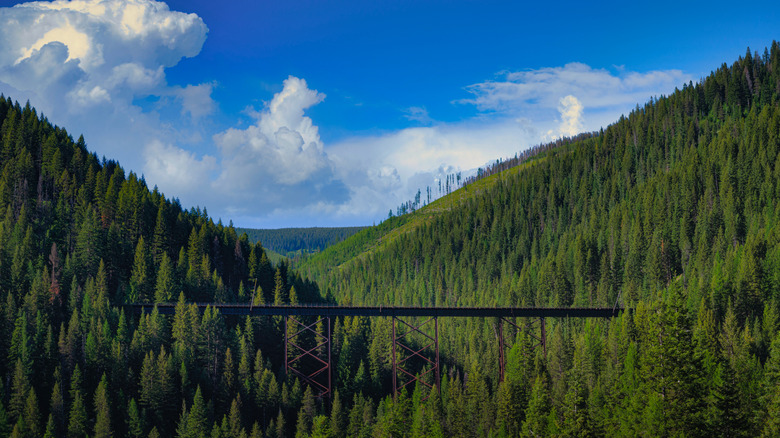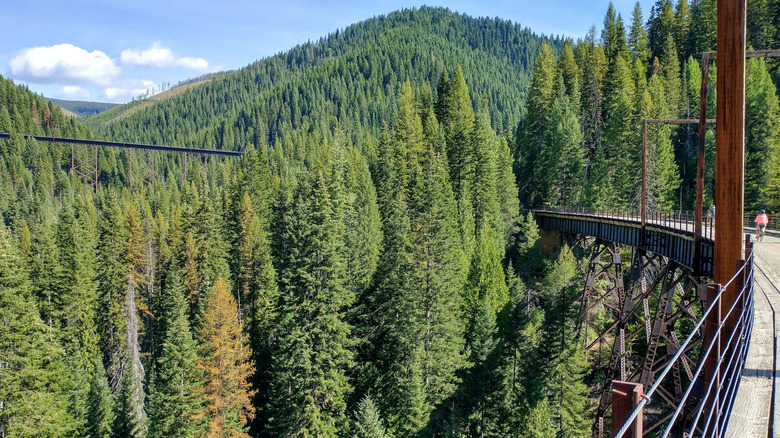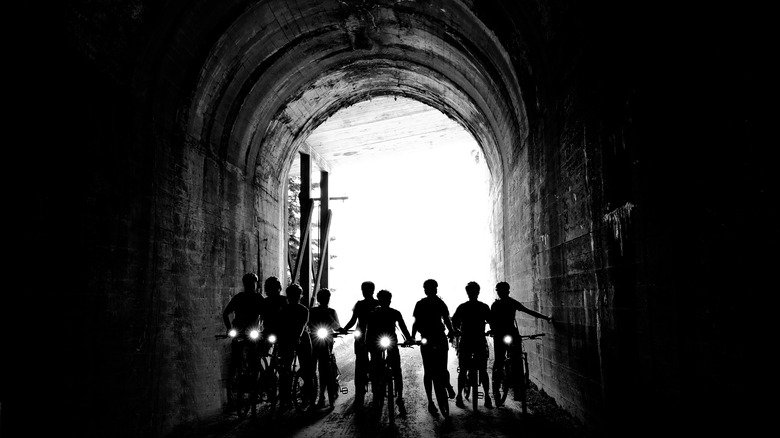One Of America's 'Most Scenic Stretches Of Railroad' Is Now A Gorgeous Idaho Trail To Bike Or Hike
The picturesque landscapes of Idaho are filled with wonderful hiking and biking trails, but few are as dramatic as the Route of the Hiawatha. Located near a town that claims to be the "center of the universe", the Route of the Hiawatha is an old railroad that's been converted into an impressive multi-use pathway. Long regarded as one of the most scenic stretches of railroad in the country, the path carves through tunnels and soars high above the forest on trestle bridges. The lengthy trail isn't for the faint of heart, but if you can overcome your fear of heights and are seeking your next big adventure, this unique path in Idaho deserves a much closer look.
Getting to the Route of the Hiawatha can be a challenge, as it's not located near any major airports. It also closes seasonally for inclement weather and tickets are required to explore the trail. That means it'll take a bit of effort to finalize your plans for this epic route, though you'll be handsomely rewarded with scenic views peering into the Bitterroot Mountains and a rolling landscape near the Idaho-Montana border. Like many of the best trails for bikers, this one lets you spend hours in the wilderness without needing the technical skills of a professional.
Biking (or hiking) the Route of the Hiawatha
The Route of the Hiawatha — named after the trains that used to run on the railroad, which in turn were named after a Native American legend — is a lengthy 15 miles, running through 10 train tunnels and across seven trestle bridges. One of the most unique sections of the trail takes you through Taft Tunnel, a 1.6-mile-long tunnel with no built-in lights, meaning you'll need to bring a headlamp or flashlight to navigate its obstacles.
Though you'll roll through some unnerving tunnels and trestles, the trail itself is fairly tame. The vast majority is downhill, and its surface is firm and excellent for biking, with various sections composed of gravel, dirt, and small cobblestones. However, the path isn't as high quality as a road, so mountain bike tires or hybrid tires are highly recommended.
Exploring the trail is an excellent way to see some of the best landscapes in Idaho, as you'll be fully immersed in the Idaho Panhandle National Forests and have plenty of opportunities to see mountains soaring above the horizon. There's also a chance you'll encounter wildlife like elk or black bears. Consider packing bear spray and reading up on what to do in case of an encounter if you're unfamiliar with this environment. While scanning the path for animals, be sure to also keep your eyes peeled for a waterfall near the West Portal of Taft Tunnel.
Planning your trip to the Route of the Hiawatha
If you're traveling from out of state, your best airport option is likely Spokane International Airport. Situated about 2 hours from the trail, it's a massive airport offering more flights than smaller regional airports closer to the Idaho-Montana border. For lodging, you could stay in the charming town of Wallace 30-minutes west, or opt for the idyllic lakefront town with ski slopes and beaches an hour away.
Before boarding your plane and figuring out your lodging, you'll need to also buy tickets and shuttle passes for the Route of the Hiawatha. The trail is open from 8:30 a.m. to 5:00 p.m. daily, though it closes in the winter. You'll also want to pay close attention to the shuttle times, as they vary throughout the week. However, your best bet is getting to the trail early in the day to ensure you have plenty of time to slowly wind through the mountains without feeling rushed. If you're not bringing a bike, you can reserve a bike rental ahead of time to save a bit of money.
There are a few ways to access the Route of the Hiawatha, but most visitors start at the East Portal and ride down to Pearson before taking the shuttle back to Roland. However, if you're looking for a challenge, you can start at the bottom and work your way uphill — then turn around and ride downhill for a total distance of 30 miles.


